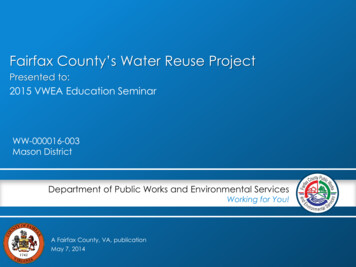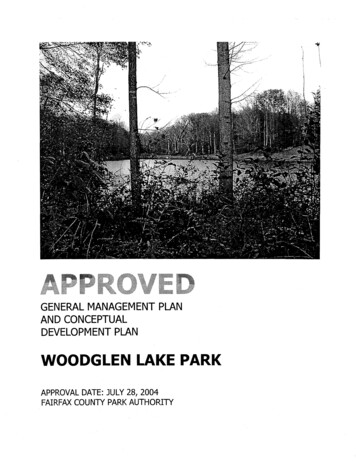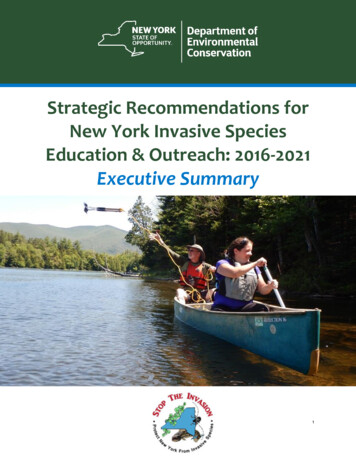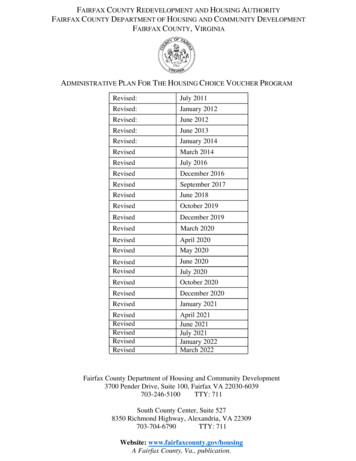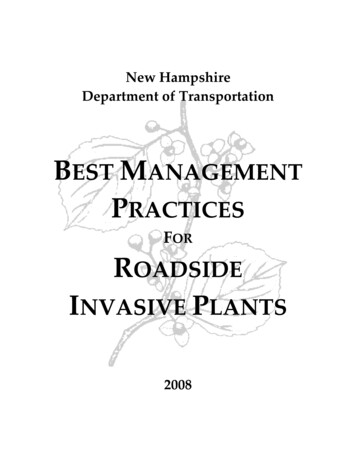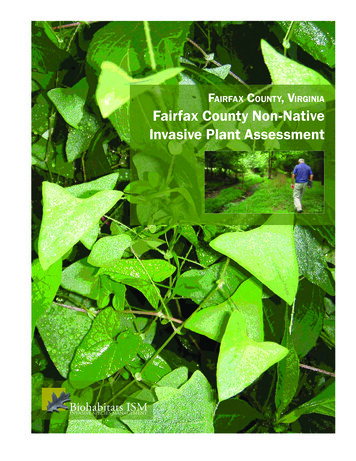
Transcription
FAIRFAX COUNTY, VIRGINIAFairfax County Non-NativeInvasive Plant Assessment
AcknowledgementsPArk Authority BoArdWilliam G. Bouie, Chairman, Hunter Mill District; Harrison A. Glasgow, ViceChairman, At-Large; George D. Lovelace, Secretary, At-Large; Frank S. Vajda,Treasurer, Mason District; Edward R. Batten, Lee District; Kevin J. Fay, DranesvilleDistrict; Gilbert S. McCutcheon, Mt. Vernon District; Ken Quincy, ProvidenceDistrict; Harold Pyon, Springfield District; Marie Reinsdorf, At-Large; Winifred S.Shapiro, Braddock District; Harold L. Strickland, Sully DistrictSenior StAffJohn W. Dargle, Jr., DirectorCindy Messinger, Deputy Director/Chief Operating Officer; David Bowden, Director,Planning & Development Division; Barbara Nugent, Director, Park Services Division;Cindy Walsh, Director, Resource Management Division; Todd Johnson, Director,Park Operations Division; Miriam C. Morrison, Director/Chief Financial Officer,Administration Division; Judith Pedersen, Public Information OfficerProject teAmHeather Schinkel, Manager, Natural Resource Management and Protection Section,Resource Management Division; Charles Smith, Resource Management Division;Meghan Fellows, Resource Management Division; Katherine Frederick, ResourceManagement DivisionThank you to staff who participated in the stakeholder meetings.conSultAntSBiohabitats, iSmKeith Bowers, PrincipalKevin Heatley, Project Manager/Senior ScientistJen Pfister, GIS CoordinatorBryon Salladin, Environmental Scientistinvasive Plant controlLee Patrick, Senior Botanistland Stewardship consulting inc.Alan Carpenter PhD., President/Senior Ecologist
FairFax County non-native invasive Plant a ssessmentTable of ContentsExecutive Summary1Introduction31.0 Methodology42.0 Results/Discussion63.0 Operational Recommendations154.0 Action Thresholds225.0 Conclusion24Literature Cited25Appendix A Phase I - Parks AssessedAppendix B Fairfax County Park Units - Fragstats Scoring ValuesAppendix C Best Management Practices ManualAppendix D Overview of Invasive Programs in Select Park JurisdictionsAppendix E Level One Scoring SheetAppendix F Level Two Scoring SheetAppendix G Treatment Projections & AssumptionsAppendix H Scoring Sheet User GuideAppendix I Recommended Control Strategies800.220.0919www.biohabitats.com Restoring the Earth and Inspiring Ecological Stewardship
FairFax County non-native invasive Plant a ssessmentExecutive SummaryIn Fairfax County extensive urbanization and forest fragmentation have created conditions that foster the establishment of non-native invasive plant species. With over 400park units and approximately 24,000 acres, the county park system is under directthreat from these organisms and is at risk of losing many of the natural assets that ledto the acquisition of these lands. Left unchecked, invasive plant species will underminethe regenerative capacity of the county forestland and ultimately produce a degradedresource that fails to meet many of the key objectives desired of the parks system.Given the dynamic nature of the invasive species threat, along with the need to maximize the effectiveness of finite control resources, the Fairfax County Park Authoritycommissioned the development of a comprehensive response strategy and site treatment prioritization model. The primary goal of this project was to develop a defensiblework prioritization model to be used by the Fairfax County Park Authority in assessingthe relative level of risk of biological invasion on parklands and in determining theproper allocation of limited resources for control. This report summarizes the projectresults and details the intervention methodologies recommended for implementation.The project consisted of two major initiatives; a qualitative assessment of the field andspatial conditions associated with the presence of invasive plants within the park system, and the development of a stakeholder and science-driven response approach.m ajor Findings Invasive species of concern were found across the entire range of park and habitattypes. Forest regeneration is being negatively impacted by invasive plants. Significant local spatial variability can be found regarding levels of infestation. Riparian corridors within the park system display a higher level of infestation thanadjacent upland areas. Invasive abundance within the county parks is closely correlated to disturbanceregimes in the form of; white-tailed deer herbivory, stormwater surges, infrastructuremodification, and park maintenance Invasive species are directly impacting the quality of the park visitor experiencer eCommendations Modify intervention goal metrics to focus upon the inherent regenerative capacityof a site to produce a sustainable native plant community as opposed to the invasiveplant infestation level. Adopt a goal of “protect the best first” that targets high value sites for restoration. Restoring the Earth and Inspiring Ecological Stewardship 1
FairFax County Park authority Implement prioritization of site treatment using a scoring system model based uponecological value, invasive threat, and cultural use. Practice prevention through the adherence and enforcement of best managementpractices on county parklands. Institute a phased treatment program for prioritized sites that utilizes contractual,internal, and volunteer resources appropriate to the level of intervention required. Undertake the development of a systematic assessment of park ecological assets andliabilities using both professional and volunteer resources. Seek deferred and yearly maintenance funding for invasive control consistent withscale of threat. Support a reduction in the county-wide population of white-tailed deer to levels consistent with the ecological carrying capacity. Support restoration of individual watershed hydrology and stream geomorphology inorder to reduce disruptive stormwater surging. Disseminate invasive plant information to public stakeholders.2 Biohabitats, Inc.
FairFax County non-native invasive Plant a ssessmentIntroductionHuman migration across the globe has resulted in rapidly accelerating changes to theearth’s ecosystems. Biotic communities that have evolved and diverged through millennia of relative geographic isolation into unique expressions of biodiversity are nowbeing threatened with dramatic and sudden change. Conservation biologists rate the intrusion of invasive species as the second greatest threat to biodiversity following habitat destruction. The introduction of invasive organisms into native systems representsan insidious threat, in many ways greater than traditional abiotic pollution. Invasivespecies are self-propagating and will multiply without the addition of new “discharges”.Their disruptive presence in a given ecosystem is unlikely to decrease over time without direct intervention.Quantifying the impact of invasive species in the United States is difficult as the damage costs are not always captured directly in the marketplace. Along with habitat destruction and fragmentation, invasive species collectively rank as one of the top globalthreats to biological diversity in natural areas, (e.g., Pimentel at al. 2000, Schierenbeck1995, US Congress 1993). They can affect multiple levels of biological organization(species, communities, ecosystems, and landscapes) and cause negative changes inecosystem structure and function, populations of native species and the compostionof native plant communities (e.g., Ehrenfeld et al. 2001, D’Antonio and Vitousek 1992,Vitousek and Walker 1991, Blackburn et al. 1982). The most fundamental effects arealterations of ecosystem structure and function as non-native invasives can change thebasic rules governing specific ecosystems. Problems that arise from invasive species aresometimes permanent and may be the most pervasive influence on biological diversityin many systems (Coblenz 1990).Of particular relevance to the Fairfax County Park Authority, invasive species arerecognized as a major and urgent threat to conservation areas and other sites managed primarily for their natural values (e.g., Timmons and Owen 2001, Randall 1996,Macdonald and Frame 1988). Invasive species are identified as a major threat in 70%of the ecoregional plans that have been completed by The Nature Conservancy (J.Randall, unpublished data). A recent review of sixty-two Nature Conservancy sitespecific conservation plans revealed that invasive species were the most frequentlycited critical threat, listed in 74% of the plans (J. Randall, unpublished data). NatureConservancy land managers have reported in surveys conducted in 1988, 1992, and1995 that invasive plants are among their worst conservation problems (J. Randall,unpublished data).Given the global scale and regional significance of the invasive species problem, theFairfax County Park Authority recognizes the need for an integrated and coordinatedresponse to this threat. This project was designed to provide pragmatic and scientifically defensible tools of value in the long-term protection and enhancement of theecological resources of the county park system. Restoring the Earth and Inspiring Ecological Stewardship 3
FairFax County Park authority1.0 Methodology1.1 deFinitionFor the purposes of this project and report, non-native invasive species (NNIs) are defined according to the descriptionprovided by former President Clinton’s Executive Order 13112(Section1e) and subsequently adopted by the National InvasiveSpecies Council:An invasive species is an alien species whose introductiondoes or is likely to cause economic or environmental harmor harm to human health.In accordance with this definition, native species that may becompeting with the development of desirable vegetation on alocal level are excluded. Examples would include such speciesas native grape, black locust (Robinia psuedoacacia) or poison ivy(Toxicodendron radicans); all of which are adapted to disturbed edgeenvironments and can produce rapid “weedy” growth. Whilesite-specific restoration goals might require suppression of thesespecies, they do not pose the same level of system-wide threat asinvasive plants.1.2 ProjeCt a PProaChThe primary goal of this project was to develop a defensiblework prioritization model to be used by the Fairfax County ParkAuthority in assessing the relative level of risk of biological invasion on parklands and in determining the proper allocation oflimited resources for control.In support of this goal a multi-phase approach was utilized.Phase one involved field visits to approximately ¼ of the parkunits within the Fairfax system by a team of professional restoration ecologists, foresters, and invasive suppression experts.Larger park units were inspected in multiple locations as a highdegree of vegetative spatial and attribute variability was apparentboth between, and within, parks. A complete listing of visitedparks can be found in appendix A. Qualitative field observationswere performed and the relative ecological integrity of individualsites ranked. Metrics ranked included, but were not limited to,plant community type, vegetative composition of forest strata,4successional stage, regeneration levels, invasive species composition and cover percentage, presence of deer herbivory, andevidence of recent site disturbance.The two primary objectives in inspecting a range of parks acrossthe county were to become acquainted with the distribution andecological processes behind NNIs occurrence in the park systemand to gain insight into the variability of ecological resourceslocated on parklands.Prior to undertaking field visits, a spatial analysis of the Fairfaxpark system was performed using geographic information systems (GIS) and the conservation planning tool FRAGSTATS.(McGarigal, Marks 1995) This tool allows for the remotedetermination of landscape parameters of significant importanceto ecological integrity. These include, but are not limited to; interior core forest size, patch size, forest connectivity, forest edgelevels, and forest edge contrast. Determination of these valuesallowed for a more informed stratification of the park field visitsand provided a statistical basis for understanding the landscapevariability inherent in the park system. Larger park units with interior core forest were given priority for assessment as conservation biology principles indicate that these units will tend to havea higher probability of containing viable native plant communities. Two of the FRAGSTATS parameters, core forest area &edge quality, were subsequently integrated into the prioritizationmodel. A breakdown of park units and their ranking scores forspatial configuration metrics can be found in appendix B.The second thru fifth phases of the project involved the development of a stakeholder-driven, scientifically defensible modelfor the prioritization of potential invasive suppression sites andthe development of operational recommendations for addressing NNIs within the Fairfax County Park Authority. An analysisof the existing peer-reviewed literature related to objectivelyprioritizing invasive suppression work efforts was performed. Inaddition, a review of the current Fairfax County Park Authorityoperational response to NNIs was undertaken and recommendedcontrol strategies, best management practices, and budgetary Biohabitats, Inc.
FairFax County non-native invasive Plant a ssessmentallocations developed. This review included the full complementof invasive response strategies being employed by the FairfaxCounty Park Authority including volunteer programs, earlydetection and rapid response, and current management practices.The intervention model developed was based upon justifiable action thresholds and an adaptive management modality. Multiplestakeholder feedback sessions were performed in order to produce an operational approach that reflected both the fundamental goals and objectives of the Fairfax County Park Authority anda consensus as to the implementation methodology best suited toanticipated resource levels. As the prioritization model is but onetool in a multifaceted response to the challenge of invasive species within the parks, additional programmatic recommendationswere developed in accordance with an integrated approach. Restoring the Earth and Inspiring Ecological Stewardship 5
FairFax County Park authority2.0 Results / Discussion2.1 Field r esults2.1.1 Species & Spatial DistributionQualitative assessment of approximately seventy-five (75) individual parks (larger parks were sampled at multiple locations)indicated that there is a large range of variability in the ecological integrity both within, and between, different park units. Ingeneral, however, the same suite of NNIs were seen across theentire county. The primary species of concern identified as having established populations in the park system are listed belowin alphabetical order. Autumn Olive (Elaeagnus umbellate) Bush Honeysuckle (Lonicera maackii, L. morrowii, L. tatarica,L.standishii) English Ivy (Hedera helix) Exotic Viburnum (V.plicatum & V. dilataum) Garlic Mustard (Ailiaria petiolata) Japanese & European Barberry (Berberis thunbergii, Berberisvulgaris) Japanese Honeysuckle (Lonicera japonica) Japanese Stiltgrass (Microstegium vimineum) Lesser Celandine (Ranunculus ficaria) Mile-a-Minute (Polygonum perfoliatum) Mimosa (Albizia julibrissin) Multi-flora Rose (Rosa multiflora) Norway Maple (Acer platanoides) Oriental Bittersweet (Celastrus orbiculatus) Porcelain berry (Amplelopsis brevipedunculata) Privet (Ligustrum species) Tree-of-Heaven (Ailanthus altissima) Wineberry (Rubus phoenicolasius) Winged Euonymus (Euonymus alata)A handful of species were located that, at the present time, haverelatively confined populations suitable for a rapid response approach and subsequent eradication. These included: Kudzu (Pueraria montana) Spreading Bamboo (Phyllostachys species)Clear differences were detected between the levels of NNIsin upland systems as opposed to riparian corridors. Riparian6(adjacent to watercourses) forests displayed a significantly greatercover percentage of invasive plants in the understory than theadjacent upland woods. This distribution pattern may be due toa number of factors such as; the frequent disturbance pattern inriparian corridors due to urban stormwater surges during rainfall events, the higher soil nitrogen levels in the floodplain, andmore prominent vectoring of NNIs propagules along streamcorridors by animal and human transport.The observation that the primary invasive species of concerncan be found across the entire county range indicates that thesepopulations, while displaying local spatial variation, are not newintroductions to the area. Given the widespread geographicdistribution of this suite of plants, suppression and containmentare the most viable control options available. This has directimplications regarding the need for a treatment prioritizationmodel that recognizes landscape differences on a site-specificscale. Understanding where suppression is most feasible and has,ultimately, the greatest chance of restoring a viable native plantcommunity is going to be critical to creating a defensible treatment program. This contrasts directly with the early detection /rapid response model which is appropriate for invasive speciesthat are relatively new to the area and currently limited to specific localized populations. Plants such as kudzu and spreadingbamboo fall outside of the prioritization model as eradication isstill a feasible option in most of their current locations.While limited populations of kudzu and spreading bamboo weredetected during the qualitative assessment phase, it is highlyprobable that, given the size and geographic scope of the Fairfaxparks system, other new introductions of currently limited,yet potentially problematic, invasive plants are present on parkproperty. As mentioned previously, newly detected populationsof invasive organisms are suitable candidates for a rapid response and eradication approach.2.1.2 Ecological DriversAs the primary goal of the field assessment was to develop aqualitative understanding of the ecological conditions associatedwith invasive plant activity in the parks, particular attention waspaid to identifying patterns and processes that were related toinvasive plant infestation. Invasive plants tend to be early suc- Biohabitats, Inc.
FairFax County non-native invasive Plant a ssessmentcessional colonizers that produce copious quantities of offspringin response to landscape disturbance. In the majority of casesinvasive plants are associated with a past or current land use ordisturbance regime that provides a competitive advantage forthe invader in getting established. The successional trajectoryof the woodland is then altered to the detriment of the historicplant community and regional biodiversity.During the field assessment of the Fairfax County parks system,a number of disturbance patterns were found to be associatedwith invasive plant activity. These disturbance regimes shouldbe recognized as important ecological drivers of invasive colonization and will need to be integrated into all treatment prioritization decisions. Correcting the primary causal agent behindecological disruption is, ultimately, a more cost-effective solutionthan repeated treatment of symptoms. Ideally, interventionsshould be coordinated with disturbance reduction in order toassure a sustainable level of NNIS suppression.Invasive plants are but a symptom of a more systemic problem –excessive deer densities.Unfortunately, the options for deer control are limited. Insuburban areas exclusion and harvest tend to be the only viableoptions. However, both of these methodologies have limitations. Exclusion with fencing is, at best, a temporary solution asit does not restore the entire ecosystem to a healthy condition.Harvesting of deer by recreational hunting is of limited effectiveness in suburban settings due to the ready availability todeer of refuge locations (such as suburban lawns). Professionalsharpshooters or trained local volunteers can have dramaticimpacts on deer densities within a single year but their value asa management tool can be challenging to communicate to thegeneral public. The key factor is removing a large percentageof the deer herd without allowing the remaining population tobecome “skilled” at avoiding harvest.In Fairfax County the primary ecological drivers of invasiveexpansion were found to be: Excessive white-tailed deer herbivory Stormwater surges and scouring of riparian woodlands Construction of park infrastructure Maintenance of park infrastructure2.1.2a Deer DisturbanceThere is a broad consensus within the scientific communitythat high deer densities are seriously degrading the ecologicalcondition of forests in the northeastern United States (Audubon2003). Excessive deer herbivory alters forest succession, reducesnative plant species, and facilitates the spread of invasive vegetation. Deer tend to preferentially feed upon desirable nativeplants and, as a result, can act as a primary agent of forest disturbance. As mentioned previously, invasive plants respond wellto disturbed sites and, if their seed source is in proximity, willrapidly colonize these locations. In many of the Fairfax parks,deer have effectively halted forest regeneration and created anunstable forest system susceptible to sudden catastrophic loss.As an example, large expanses of the Sully Assemblage lack native understory and desirable regeneration due to deer damage. Restoring the Earth and Inspiring Ecological Stewardship Absence of forest regeneration due to deer herbivory – Sully AssemblageAs Fairfax County previously contracted for a deer managementplan (Shissler 2001), the Biohabitats team strongly recommendsthat it be fully funded and implemented. As professional sharpshooting can range from 200 to 600/deer, local volunteertalent is a much more attractive option. The direct relationshipbetween excessive deer densities and the prevalence of NNIs inthe understory of many Fairfax county parks (example – HuntleyMeadows) can not be overstated. The local level of herbivorypressure from deer is often the primary variable impacting restoration success.7
FairFax County Park authority2.1.2b Stormwater DisturbanceImpervious surfaces in urban areas reduce the capture andsoil infiltration of water during rainfall events, resulting in anexcessive flow of runoff to stream channels. Stream degradationbegins to become evident when more than 10% of the watershedis occupied by impervious surface. In Fairfax county stormwaterdischarges are of significant enough volume to change not onlythe geomorphology of receiving streams, but in addition, theriparian understory vegetation. Frequent disturbance in the formof heavy scouring of floodplains, coupled with the transportof invasive propagules (seeds and vegetative parts) has allowedfor the establishment and eventual dominance of undesirableinvasive plants.Clear evidence of this mechanism of dispersal can be seen inthe spatial pattern of Japanese stiltgrass in riparian corridors.Stiltgrass is an annual plant and is readily spread through watertransport. In Fairfax County, stiltgrass was found to predominate along the lower sections of stream valleys. It was much lessprevalent in headwater areas. Movement of stiltgrass propagulesvia roadside drainage catchbasins and culverts allows this aggressive plant to enter and colonize previously uninfested areas.Over a period of years, coupled with deer damage, a monoculture of stiltgrass becomes established.An excellent example can be seen in the following photographsfrom Sugarland Run Stream Valley. The photo to the left is aheavily armored catchbasin designed to quickly move heavy volumes of stormwater off of the landscape and into the receivingstream of Sugarland Run. The photo to the right illustrates thecarpet of stiltgrass that results from this excessive runoff.The disturbed hydrology of this site is typical for many of theriparian parks in Fairfax and has important repercussions forinvasive treatment. Until the hydrology is repaired, suppressionof invasive plants within a lower floodplain such as SugarlandRun, has little chance for long term success. Re-infestation isguaranteed unless the upstream seed source can be eliminated.Unfortunately, that seed source is likely to reside on privateproperty and fall outside of the jurisdiction of the FairfaxCounty Park Authority8Sugarland runUpstreamDownstreamShould invasive treatment be warranted in a riparian corridor, itwould be prudent to begin the treatment process in the headwaters if possible. Over a period of years treatment can progressdownstream as propagule reservoirs become depleted in theupstream region.2.1.2c Construction / Maintenance DisturbanceThe third major disturbance variable that was found to beenhancing the establishment of invasive vegetation within thepark system is the construction of incompatible infrastructureand associated maintenance practices. The sighting and development of park hardscape can have a tremendous impact onnative plant communities and their inherent capacity to resistNNIs. Activities that create gaps in the forest canopy throughexcessive pre and post-construction tree mortality allow lightlevels to increase on the forest floor. If a population of NNIs ispresent prior to tree loss, or if a local seed source is nearby, theadditional light penetration will cause an explosive increase inthe percent cover of these species on the forest floor. Duringthe site review, multiple examples of tree decline and death as aresult of construction related root damage were clearly evident.The inadvertent loss of decade’s worth of accrued canopy covercreates impacts that ripple through the entire local ecosystem.Fortunately, simple tree preservation tools are available that canavoid most of this damage if adopted and implemented duringthe project design and construction phases.While the trail system is a major asset that draws residents intothe park system and engages them with the landscape, it isalso, conversely, the primary park infrastructure element thatis adversely impacting ecological integrity. Tree loss, as mentioned above, is clearly evident adjacent to newly constructed Biohabitats, Inc.
FairFax County non-native invasive Plant a ssessmentAdoption of invasive Best ManagementPractices offers a cost-effective, preventativeapproach that will save thousands of dollarsin future remedial restoration expenses.Japanese Stiltgrass “hitchhiking” on mower decktrail sections. In addition, changes in site hydrology associatedwith poorly designed stormwater culverts are directly vectoringJapanese stiltgrass propagules into formerly uninfested areas.These trail-related conditions are common within the park system. In general, it was found that; the larger the trail width, thegreater the ecological footprint penetrated into the forest.The maintenance of trail edges is also a major source of invasivespread and propagation. Trailside mowing and drainage clearing are currently responsible for massive incursions of Japanesestiltgrass into the forest understory. Mowing after seedhead production transfers stiltgrass along the trail corridor where it theneventually migrates into the neighboring woodland. Evidence ofthis dispersal mechanism was seen in parks of all sizes and locations. The problem is so ubiquitous within the Fairfax park system that the Virginia Department of Conservation & Recreationhas utilized trail examples from Fairfax to demonstrate thenegative ecological consequences of improper trail maintenance(Fleming 2009). Restoring the Earth and Inspiring Ecological Stewardship Of particular concern given the trailside proximity that this species enjoys is the degradation of the user experience. For manypark patrons the trail system is the closest opportunity that theyhave to interacting with the native biota of Fairfax County. Thereplacement of desirable native species with stiltgrass along thepark trail system, in effect, “teaches” park users that this is a“normal” landscape.Fortunately, the invasive-propagating disturbance associatedwith infrastructure construction and maintenance practices isreadily amendable to correction through internal policy andorganizational adjustments. It is strongly recommended thatthe Fairfax County Park Authority implement and enforce therecommended Best Management Practices (BMPs) developed asa component of this project (appendix C). Adoption of invasiveBest Management Practices offers a cost-effective, preventativeapproach that will potentially save millions of dollars in futureremedial restoration expenses.2.1.3 Forest RegenerationThe sustainable management of a primarily forested landscape,such as that present on the parklands of Fairfax County, requiresan understanding of long-term successional trajectory. The forest of the future requires planning today. Field assessment ofthe county parklands indicates that the majority of the sites arecomposed of even-aged stands of secondary and tertiary forests.These are remnant woodlands that likely became establishedfollowing the cessation of historic land use disturbances such asagriculture or timber and fuelwood extraction. Under normalcircumstances most of these stands would begin to convert toshade tolerant species in the understory. However, in many ofthe parks there is a pronounced lack of desirable tree regeneration on the forest floor. High deer densities have removed muchof the native regeneration. Invasive plants, unpalatable to deer,have moved in to occupy the vacant ecological niches. Largeareas of the county park system are not regenerating forest coverand will cease to be occupied by a desirable tree canopy withoutactive intervention.Large areas of the county park system arenot regenerating forest cover and will ceaseto be occupied
tions that foster the establishment of non-native invasive plant species. With over 400 park units and approximately 24,000 acres, the county park system is under direct threat from these organisms and is at risk of losing many of the natural assets that led to the acquisition of these lands. Left unchecked, invasive plant species will undermine


